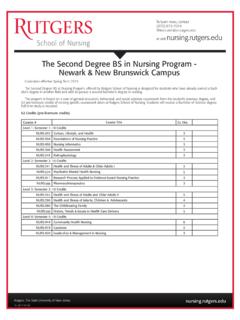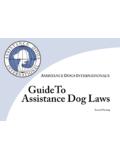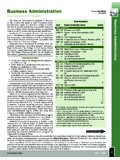Transcription of Washington State Institute for Public Policy - wsipp.wa.gov
1 110 Fifth Avenue SE, Suite 214 PO Box 40999 Olympia, WA 98504 The 2013 Washington State Legislature directed the Washington State Institute for Public Policy (WSIPP) to review the research evidence on components of successful early education program strategies for low-income In this report, we present findings from our analysis of early childhood education (ECE) research. We conducted this analysis by reviewing all credible evaluation studies from the United States and elsewhere. We systematically analyzed the studies to estimate whether various approaches to ECE have a cause-and-effect relationship with outcomes for low-income students. We then calculated whether the long-term monetary benefits of ECE investments outweigh the costs.
2 Research on ECE programs serving low-income children can provide insight on the effectiveness of Washington s own program, the Early Childhood Education and Assistance Program (ECEAP). The 2013 Legislature also directed WSIPP to conduct a comprehensive retrospective outcome evaluation and return on investment analysis of ECEAP. That evaluation will be completed by December 2014. The full legislative direction to WSIPP is in Exhibit 1 (next page). In this report, we first describe WSIPP s approach to systematic research reviews and benefit-cost analysis. We then highlight our findings on the average effectiveness of ECE for low-income 1 Senate Bill 5904, Laws of 2013. 2 We focus our analysis on programs for low-income children because Washington s ECEAP primarily serves this population.
3 January 2014 Early Childhood Education for Low-Income Students: A Review of the Evidence and Benefit-Cost Analysis Summary WSIPP analyzed how various approaches to early childhood education (ECE) for low-income children impact student outcomes and whether benefits exceed costs. We examined three types of programs: State and district pre-kindergarten, the federal Head Start program, and model programs. To investigate, we conducted a systematic review of research by collecting all studies we could find on the topic. We screened for scientific rigor and only analyzed studies with strong research methods. We identified 49 credible evaluations of whether the three types of ECE for low-income children have a cause-and-effect relationship with student outcomes. The studies in our review measured academic as well as social and emotional development outcomes; a few studies also measured longer term outcomes including crime and teen births.
4 Our bottom-line findings. Our analysis shows that ECE for low-income children can improve outcomes. In scaled-up State , district, and federal programs, the long-term benefits have a relatively high probability of outweighing program costs. We find that the typical State program outperforms the federal Head Start program, but both have favorable results. Unfortunately, scientifically rigorous research identifying specific ECE program components critical to producing improved outcomes is scarce. In this report we present preliminary evidence on the association between teacher degree attainment, classroom quality, and student outcomes. Next steps. As directed by the 2013 Legislature, WSIPP is conducting a retrospective outcome evaluation of Washington State s Early Childhood Education and Assistance Program.
5 Results will be available by December 2014. 110 Fifth Avenue SE, Suite 214 PO Box 40999 Olympia, WA 98504 W a s h i n g t o n S t a t e I n s t i t u t e f o r P u b l i c P o l i c y 2 I. Research Approach When WSIPP carries out assignments from the legislature to identify what works (and what does not) in Public Policy , we implement a three-step research approach. Step 1: What Works? What Does Not? In the first research step, we estimate whether various Public policies and programs can achieve desired outcomes, such as high school graduation . We carefully analyze all high-quality studies from the United States and elsewhere to identify Policy options tried, tested, and found to impact outcomes. We look for research studies with strong evaluation designs and exclude studies with weak research methods.
6 Our empirical approach then follows a meta-analytic framework to assess systematically all credible evaluations we can locate on a given topic. Given the weight of the evidence, we calculate an average expected effect of a Policy on a particular outcome of interest, as well as an estimate of the margin of error for that effect. Step 2: What Makes Economic Sense? Next, we insert costs and benefits into the analysis by answering two questions: How much would it cost Washington taxpayers to produce the results found in Step 1? How much would it be worth to people in Washington State to achieve the improved outcome? That is, in dollars and cents terms, what are the costs and benefits of each Policy option? Exhibit 1 Legislative Study Direction The 2013 Washington State Legislature, in Senate Bill 5904, adopted the following study language for WSIPP: (1) During the 2013-2015 biennium, the Washington State Institute for Public Policy shall conduct a comprehensive retrospective outcome evaluation and return on investment analysis of the early childhood program established in RCW To the extent possible based on data availability, the evaluation must: a) Assess both short-term and long-term outcomes for participants in the program, including educational and social outcomes.
7 B) Examine the impact of variables including, but not limited to, program fiscal support, staff salaries, staff retention, education level of staff, full-day programming, half-day programming, and classroom size on short-term and long-term outcomes for program participants; c) Report findings from a review of the research evidence on components of successful early education program strategies; d) Examine characteristics of parents participating in the early childhood and education assistance program; and e) Examine family support services provided through early childhood programs. (2) The Institute shall submit a report to the appropriate committees of the legislature by December 15, 2014. This report focuses on section (1)(c) of the study direction. A December 2014 report will address the remainder of the study assignment.
8 3 To answer these questions, we developed, and continue to refine, an economic model that estimates benefits and costs. The model provides an internally consistent monetary valuation so that Policy options can be compared on an apples-to-apples basis. Our benefit-cost results include standard financial statistics: net present values and benefit-cost ratios. We present monetary estimates from three perspectives: a) program participants, b) taxpayers, and c) other people in society (for example, we estimate spillover effects to society of increases in education).3 The sum of the three perspectives provides a total Washington view on whether a Policy or program produces benefits that exceed costs. 3 McMahon, M. (2010). The external benefits of education.
9 In Brewer, , & McEwan, eds. Economics of education. Oxford, UK: Academic Press. Step 3: What is the Risk in the Benefit-Cost Findings? Any tabulation of benefits and costs involves some degree of risk about the estimates calculated. This is expected in any investment analysis, whether in the private or Public sector. To assess the riskiness of our conclusions, we perform a Monte Carlo simulation in which we vary the key factors in our calculations. The purpose of the risk analysis is to determine the odds that a particular Policy option will at least break even. Thus, for each option analyzed, we produce two big picture findings: expected benefit-cost results and, given our understanding of the risks involved, the odds that the Policy will at least have benefits that are greater than the costs.
10 Readers interested in an in-depth description of the research methods for these three steps can reference our Technical A summary Technical Appendix is included at the end of this report. 4 Washington State Institute for Public Policy , (2013). Benefit-cost technical manual: Methods and user guide. (Doc. No. 13-09-1201b). Olympia, WA: Author. 4 II. Early Childhood Education for Low-Income Children The impact of ECE for low-income children has been studied since the 1960s when model programs such as Perry Preschool and Head Start demonstration programs were initiated. As of 2011, 40 State governments and Washington , funded ECE in most cases for low-income children, and in a few, for all children within the Other low-income children receive federally funded preschool through Head Start.








